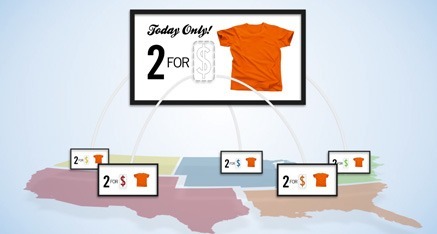
Three Ways To Build Digital Signage Ads And Messages On Tight Budgets
November 28, 2014 by Dave Haynes

Digital signage networks have insatiable appetites for fresh content and creative, and producing that material can turn into one of the biggest line items on a network’s operating budget.
Creative costs can easily shoot into five and six figures annually, even higher on large national deployments.
For a lot of small to medium business sign networks, even getting five figures budgeted is tough. Creative can be the last thing approved, and the first budget item to get sawed off. Doesn’t matter how many people say content is king.
So what happens?
Material stays on network screens far too long, or the programming includes entry-level, ineffective creative that isn’t up the standards you want, or what the audiences expect.
Fortunately, emerging software and cloud services are making it possible for network operators to generate steadily fresh creative even on the tightest budgets. It ranges from automated tools to talent marketplaces that connect freelancers with clients in ways not previously possible.
Here’s a rundown of low-cost options that might work for you as a network operator or solutions provider:
Automagic Videos
There are a handful of platforms on the market that can produce video advertising and messaging using templates that loaded into a cloud-driven platform. They make it possible for people with no specific motion graphic skills, or software, to generate polished videos that are ready to run on digital sign networks.
Sp0tomate (ad spots, automated … get it?) is the newest kid on the block, a platform that uses the full graphic design power of Adobe After Effects – the software of choice for most pro designers – and puts a browser-based user interface on the front-end, removing the need for specialty software or user skills.
(Disclosure: the author started and runs Spotomate)
All Spotomate users do is drag images into placeholders and replace text in forms, and Spotomate renders what it describes as agency-grade videos for $75 or less. There are dozens of templates, many of them flexible enough to be used for different products and services. For example, Spotomate customers are using high-energy auto dealer ads to promote fitness clubs.
Visible Spectrum has some similarities to Spotomate, in that HD videos are designed in a browser and rendered in the cloud. But VSI resembles video edit software with timelines and layers, and plugs into image databases, such as product shots and photo libraries. Like Spotomate, there are dozens of templates, and users only pay for downloaded files after they see proofs.
Producing a video starts at $125 using VSI.
http://youtu.be/oXhoZRBElok
This is not a pure-play digital signage service, but Animoto has been around for years, turning folders of photos into auto-generated video slideshows Animoto, says the NYC-based company, automatically produces beautifully orchestrated, completely unique video pieces from your photos, video clips, and music. It takes a little experience and tweaking to get the timing down, but for $300/year, a company can knock out an unlimited number of unbranded HD video spots.
While Animoto started as and remains a company focused on the business to consumer market, it has a distinct business to business offer, as well.
http://youtu.be/h5cXAh0eiY0
There’s also Viddyad, which overlays messages on stock media assets, and will generate a 15-sec. spot for $199. And ScreenFizz, a French firm that does basic motion videos using text and images, and uses a pre-purchased credit system (therefore hard to pin down price).
Managed Templates
Many digital signage software platforms – even some of those developed by the big screen manufacturers – come with built-in or cloud-based tools for producing content.
Some software companies, such as Scala, have their roots in creative design and have highly advanced design editors. Most, however, have more basic template libraries designed for non-creative staff to use.
They’re usually browser-based and have assigned log-ins and controls that enable, for example, a manager in a retail chain to make very basic changes to sales, price and store information by selecting images and keying in text.
It’s very rare that these template libraries – usually static images or sometimes using some simple motion tricks and transitions – can take the place of motion graphic ads and messages. But they do offer a very low cost way to at least keep screens fresh.
There are also companies that offer more polished templates and content updating/automation tools.
 Flypaper is an Adobe Flash-based platform that lets programmers and non-programmers create, edit, share, track and reuse high-impact video content. Users can develop video or interactive digital signage content without needing to know anything about Flash programming.
Flypaper is an Adobe Flash-based platform that lets programmers and non-programmers create, edit, share, track and reuse high-impact video content. Users can develop video or interactive digital signage content without needing to know anything about Flash programming.
Flypaper started as a content creation tool but now has a full management platform for digital signage. The system uses templates and pre-programmed Flash components. Flypaper does not directly publish its pricing.
It’s challenge may be that digital signage and media in general is shifting away from Flash to HTML5, and many low-cost media players now being used on networks do not support Flash.
 Wave is a web-based template program that is tied to dynamic information, such as a retailer’s web or mobile site. Wave offers a library of templates, or custom templates, to promote products and pricing. The platform includes a dashboard to select and schedule promotions, and also call and display information that can change automatically. Wave does not publish its pricing, likely due to the wide and shifting variety of customer requirements.
Wave is a web-based template program that is tied to dynamic information, such as a retailer’s web or mobile site. Wave offers a library of templates, or custom templates, to promote products and pricing. The platform includes a dashboard to select and schedule promotions, and also call and display information that can change automatically. Wave does not publish its pricing, likely due to the wide and shifting variety of customer requirements.
Hire In-House or Use Freelancers
The other option, of course, is to hire motion graphic designers out of schools and grow them into the job. They can take advantage of low-cost After Effects project files from sites like VideoHive for foundational designs, and for inspiration. It’s possible to buy project files for $50 and less. However, using these kinds of files requires specific skill and experience, usually needs many hours of labor, and must be done using costly, specialized software.
But watering and feeding even entry-level designer positions is outside the budget of most SMBs. More to the point, most network operators, solutions providers and systems integrators don’t have the creative experience to manage and direct junior creative people. It’s not their core business.
There are many online marketplaces, such as eLance and oDesk, where it’s possible to tender a project and get proposals back from around the globe. The work can be very good, but there can be many challenges with language, time zones and differing points of view. Full outsourcing of creative to overseas teams has been tried, and requires a steady investment in communication and time to make work.
Summing Up
So depending on what you need, give one of these options a crack. There might be something there to help you feed the content beast and make your network thrive.



Great and informative post! A great signage company can assist with creating a great design and also provide great payment options. Thanks for sharing!